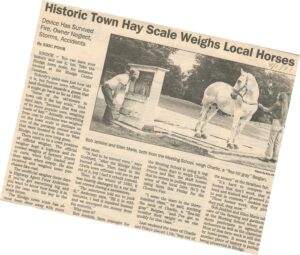Holding on to Tradition

In Rindge, memories of past events have a way of popping up to be relived for new generations of citizens. One of those memories is the time worn Town Scale or Hay Scale as it is commonly known, located along Main Street by the Town Common.
In times past, there have been other scales in Rindge. One was located in East Rindge near Mechanics Hall and the oldest, going back perhaps for a hundred years, was situated near the Rindge Hotel which burned down in 1902. A private set of scales in West Rindge was owned and operated by Seth Cleaves. Unfortunately, no trade of these scales now exists and all that remains of their passing are faded pictures and memories gleaned from oral histories.
But unlike most towns in the state, Rindge has a working and viable set of scales thanks to the efforts of several people and organizations over the period of over eighty years. Like all major expenditures made by towns, the set of scales started as Article 19 and 20 of the Town Meeting of 1924. Article 19 stated: “Voted that the Town raise and appropriate the sum of $350.00 for the purpose of purchasing a set of ten ton hay scales for Rindgde Center and erecting same.” Article 20 stated:S “George C. Todd, James R. Danforth, and W.E. Hale were appointed a committee to establish and look after same.”
A year later in the Town Report of 1925, George C. Todd, the Town Highway Agent, submitted the Financial Report of Committee on Town Scales. The bottom line of this report, like so many cost overruns, was $702.96. Here is how the cost of living and price of materials changed the final total.
Materials: $370.73 – Scales $207.55, hinges, screws, bolts $3.91, 71 bags of cement, $53.25, paint, lock, and hasp $1.29, lumber and millwork $90.63, plus other minor expenditures.
Labor: $220.63 – As in today’s economy, labor costs are always high. As examples, James R. Danforth was paid 10 cents an hour and labvorersHenry Buzzell and Hervert Popple were paid $4.00 per day.
When you add the cost of grading, $111.60, the scales were finally set to do their work by the Town Meetingf of 1925. Now you ask, what was weighed and by whom? Each town had a person in charge of weights and measures, which in many cases was the Highway Agent. Over the years, farmers would bring in their bales of hay in wagons and later on in trucks, Town purchases of coal were recorded, animals of various varieties were weighed and in general, anything oversized or too heavy for normal scales could be accommodated.

In the 1940’s, the scales were outmoded and in disrepair. Roland Goddard, the Town Clerk at the time, was told by the Selectmen to get rid of them, but Roland seeing their historic value had them repaired instead. Over the ensuing years, the focus of the scales changed and although they were still used for some of the old purposes, more and more they went into disuse.
The doom of the set of scales seemed to come in the winter of 180 when a motorist’s car slipped off the road and slammed into them. The selectmen told the Highway Agent, Peter Anderson, to finally end of the life of the scales, but like Roland Goddard, Peter was able to tract the money from the accident and repaired the scales for a second time in their history.
Through the 80’s and 90’s, the scales had a rebirth of purpose. Pulling contest at state fairs required that draft animals’ weight be verified in order to enter various classifications of competition and what better place to do so than here in Rindge. Another use started in 1990 when POOR (Pumpkin Organization) started a weighing competition for giant pumpkins for “bragging” rights in Rindge and neighboring towns.
Seeing a need to maintain the scales, in 1992 the POOR Organization invested time and money to refurbish and recalibrate the old scales, but since then, time and weather has taken its toll and much needs to be done to restore our Town treasure. The search for benefactors has begun, but up to this time, the scales are still in place and the tradition lives on.
Roland J. Cleland
Amy Raymond – Research
Rindge Historical Society
